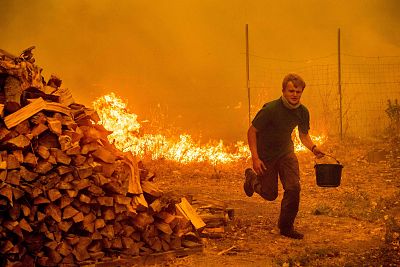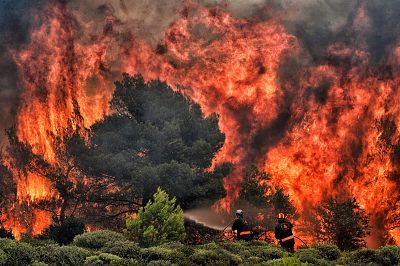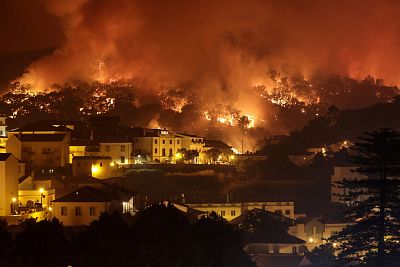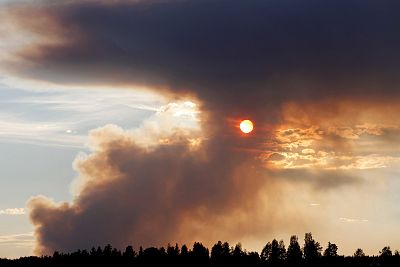"We're starting to look at wildfire as a nonseasonal event. It can happen at any time of year, and we have to be prepared," one expert warned.
From northern Sweden to Southern California, wildfires swept the globe in 2018.
But it wasn't simply the size of the blazes that was notable but the timing, proximity to cities and resulting death toll, experts said.
Fires are typically associated with the hot, dry months of summer, but increasingly, firefighters are getting little reprieve during the traditional off-season.
"We're starting to look at wildfire as a nonseasonal event," said Omar Baddour, chief of climate data for the World Meteorological Organization. "It can happen at any time of year, and we have to be prepared."
California was hit hard with the most destructive fire on record, the so-called Camp Fire, which started on Nov. 8. The blaze destroyed nearly 14,000 homes and structures as it swept across 153,336 acres. Nearly 90 people died.
There were fewer fires in the U.S. during 2018 compared with the annual average over 10 years since 2008, but the area destroyed was far greater than normal, said Carrie Bilbao, a spokeswoman for the National Interagency Fire Center, in Boise, Idaho.
"Our fire seasons are becoming fire years," Bilbao added.
The Mendocino Complex in California was the largest fire on record, burning 459,123 acres — almost twice the size of San Diego — through the summer.
The blaze was so big, smoke could be seen from space.
In Canada, fires in British Columbia also broke records. They destroyed 3.3 million acres, suffocating communities with smoke.
There are many factors that contribute to the size and spread of wildfires. Drought conditions and high temperatures, of course, create an environment for fires to start easily, while winds can rapidly spread them, Baddour said.
#embed-20181220-wildfires iframe {width: 1px;min-width: 100%}
More rainfall would seemingly help prevent fires, but it can also make matters worse. Rain encourages the growth of plants and trees, providing more fuel for fires when dry conditions return, Bilbao said.
The U.S. was not the only place where fires broke out near cities.
In Greece, more than 90 people were killed as fires raged near Athens, the capital, with wind gusts of up to 77 miles per hour fueling the flames — unusual conditions for July.
A lack of understanding among the public of how quickly a fire can spread may have contributed to the high death tolls this year, according to Baddour. Authorities may also have been surprised by the longer fire season and the areas affected.
This year's extreme heat fueled some of the worst fires around the globe.
In Portugal, where temperatures topped 114 degrees this summer, fires also consumed nearly 52,000 acres and left at least 40 people with injuries.
It doesn't take much to have the right conditions for fires to start. If temperatures are above 77 degrees and it's dry, fires can ignite regardless of the month.
Some places in Europe are starting to see those conditions in January, Baddour said.
This past summer, temperature records were broken around the world as lengthy heatwaves contributed to at least 1,600 deaths, according to the World Meteorological Organization. These conditions led to abnormal fire activity in Norway, Germany, the United Kingdom and Ireland.
"We can absolutely make connections between the intensity of wildfires and climate change," Baddour said.
In the Arctic, the consequences of climate change have become readily apparent. In northern Sweden, 50 fires started in July, torching an unprecedented 60,000 acres by the end of the season, according to the World Meteorological Organization. In Finland, 61,000 lightning strikes were recorded in August — twice as many as usual.
While it's difficult to forecast what's in store for 2019, Baddour said that the weather system known as El Nino was weak to moderate this year, and that could mean high temperatures for the U.S.
El Nino is already causing high temperatures in Australia. Warnings ranging from high to catastrophic risk for fire have been issued across the country after record-level dryness and heat.
Forest management can help mitigate extreme fires, but the U.S. fire center's Bilbao said there is no silver bullet amid changing weather patterns. And solutions that are effective in one area aren't always applicable elsewhere.
Instead, keeping people safe in the face of spreading fires remains the priority.
"Unfortunately it's becoming more common for people to have to evacuate," Bilbao said. "And it doesn't look like it's going away."















